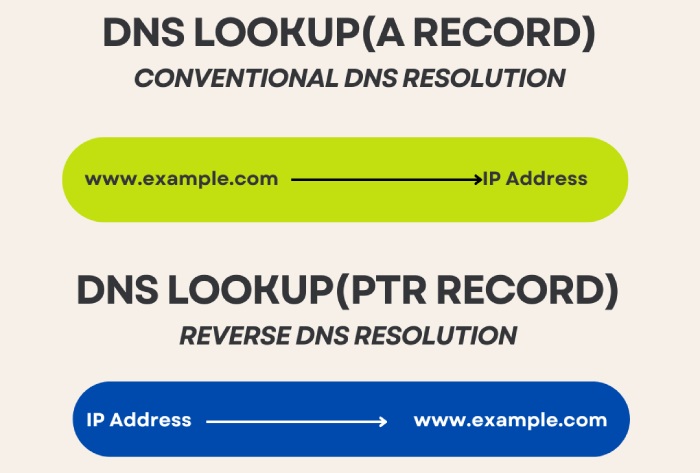Understanding PTR DNS Records for Emailing
If you have a website’s IP address and don’t know its domain name, you would need to perform a PTR lookup. A PTR record, which is short for a Pointer Record, is the opposite of an A record; an A record translates domain names into their corresponding IP addresses, and a PTR record translates IP addresses into their corresponding domain names.
This whole concept is relevant to emailing as it helps in email authentication done using SPF and DMARC, spoofing prevention, and overall reputation and trust assessment for an email sender.
Let’s wrap our heads around this in a better way.
Relevance of PTR DNS Records to Emails
The number of emails exchanged per day worldwide is projected to grow to 392.5 billion by 2026, and this figure definitely demands a more secure, accurate, and trustworthy email infrastructure across the world. PTR records focus on email security by helping with the following-
Reverse DNS Lookup for IP Validation
Email servers can perform reverse DNS lookups on the IP address of the sending servers of incoming messages. The PTR records linked with those IP addresses should match the sending servers’ hostnames to ensure senders are genuine.
SPF Authentication
SPF is an email authentication method that allows domain owners to specify which mail servers are authorized to send emails on behalf of their domains. SPF records often include IP addresses and PTR records are used to ensure that the reverse lookup of those IP addresses matches the original domain.
DMARC Authentication
DMARC is another email authentication protocol that instructs recipients’ servers to reject or place suspicious emails in spam folders so that victims don’t engage with them. PTR DNS records are part of the overall email authentication process that ensures the IP address used for sending an email has a valid reverse DNS entry.
Spam Prevention
Many spam filtering and email security tools use PTR lookups to analyze and identify suspicious or malicious emails. Legitimate email servers should have accurately configured PTR records, as spam filters consider their absence a red flag.
Reputation and Trustworthiness Among Mailboxes
Email service providers and spam filters consider PTR records as part of an email sender’s overall reputation assessment. A consistent and accurate PTR record is seen as a good sign and improves the sender’s reputation, while discrepancies and inconsistencies trigger errors and suspicions.
PTR Records Boost Email Security
A PTR record is a preliminary record that filters out suspicious and unverified sources, minimizing the possibility of victims falling into traps and getting carried away into sharing sensitive details or transferring money.
It acts as an initial checkpoint for the entry of wrong-doers. It ensures that a Forward-Confirmed reverse DNS lookup check passes.
How Does a Forward-Confirmed Reverse DNS Lookup Work?
A Forward-Confirmed Reverse DNS Lookup is also called a ‘double-reverse’ DNS lookup, a method that verifies the relationship between the IP address of a host and its associated domain name.
A reverse DNS lookup using a PTR record is performed to ascertain that the domain name is actually linked to a legitimate IP address. This is followed by a forward DNS lookup on the obtained domain name to verify if it aligns with the initial IP address. When both lookups align, the Forward-Confirmed Reverse DNS verification succeeds, signifying a legitimate association between the IP address and domain name.
The Importance of Setting Up PTR Records
How a PTR record should be configured depends on a business’s scope, scale, operational style, and its services or products. So, a small or mid-size company with a simpler email infrastructure and Microsoft 365 or Google Workspace as its hosting provider may not need to set up a PTR record. However, if you are a domain owner of an intricate and extensive business, you need to consider the following-
Directly Allocated IP to a Company
Organizations that have their own range of IP addresses allocated by their internet service provider, hold autonomy and are capable of handling all types of DNS records, including PTR records. This management control helps establish a strong grip over the email ecosystem since a properly set PTR record is a sign of legitimacy to recipients’ mailboxes and email servers. This ultimately improves your sender’s reputation and engagement rate.
So, if your situation is also like this, you must ensure that all outbound SMTP email servers have their respective PTR records to translate to verifiable domain names. Ensure you and your IT or cybersecurity team regularly monitor this exercise and don’t completely forget about it after deployment. By saying this, we mean that there should be coordination with the ISP that routes your company’s web traffic, as they are responsible for the reverse DNS zone where PTR records are configured.
Hosting Services Allowing Custom PTR Labeling
Many cloud and hosting services allow users to customize their PTR records for the sake of unhampered email delivery. This flexibility lets you maintain uniformity and accuracy between domain names and IP addresses of these service providers. The process of setting them up may differ slightly from platform to platform, but the overall technical drill remains more or less the same.
To ensure a stable and hassle-free setup, you can watch tutorials, read how-to blogs, or contact their customer support teams.
We recommend you discuss this part in detail during onboarding with the service providers. It’s important your idea of configuration matches their range of flexibility.
Hosted Services with Pre-Setup and Non-Customizable PTRs
Big email service providers like Microsoft and Google manage emails for millions of organizations and, hence, cannot offer much flexibility to customers. So, they themselves ensure that their IP address ranges are accurately configured.
To prevent this inability from becoming a constraint for customers, these service providers work hard to strategize preconfigured PTR records, aiming to sustain high deliverability rates and fortify against spam and phishing.
So, if you are one of the organizations that depend on hosted services, it’s important that you choose a reputable and dependable provider.
Now, Google and Yahoo also require proper configuration of PTR records. So, ensure you comply with their requirements; otherwise, your domain might get blocked. Reach out to us for further help.



